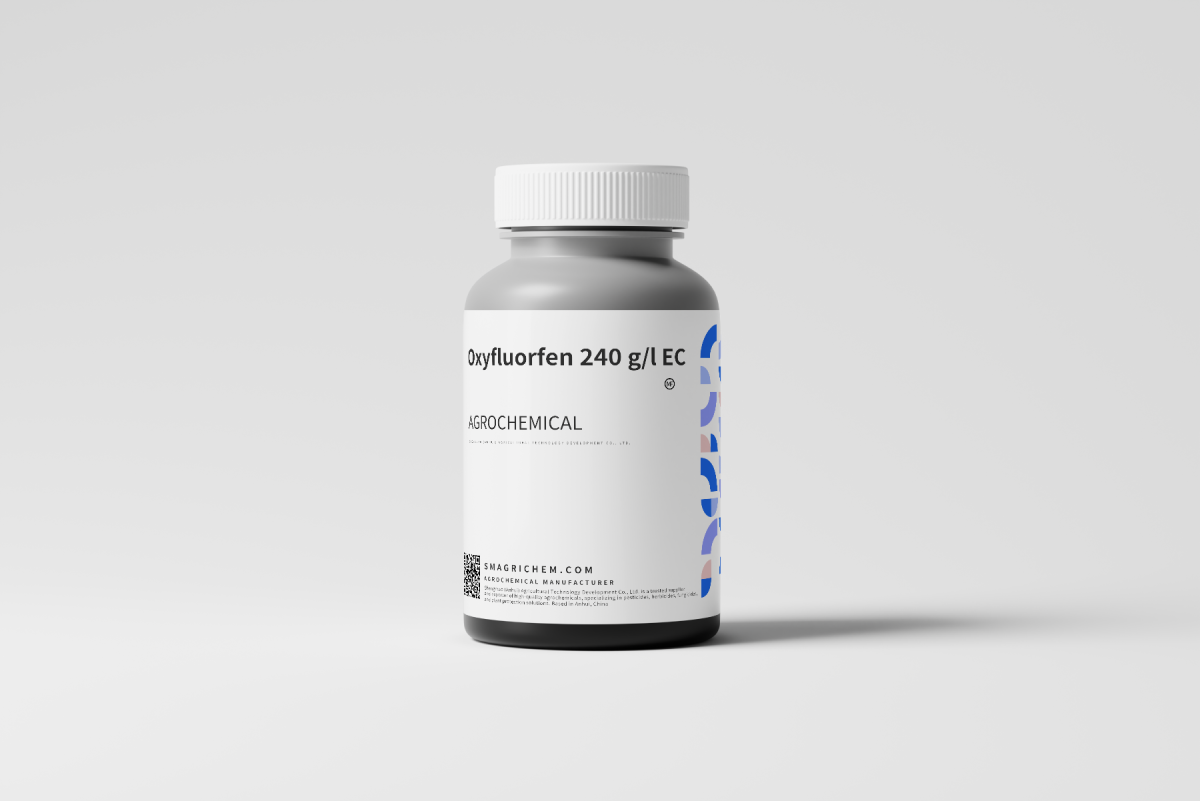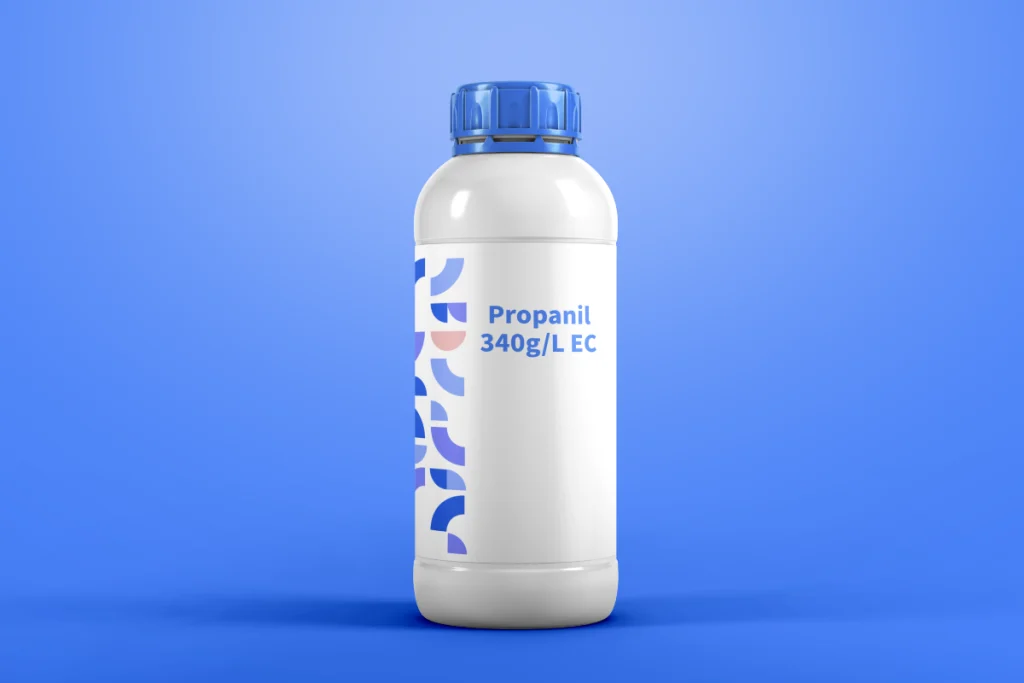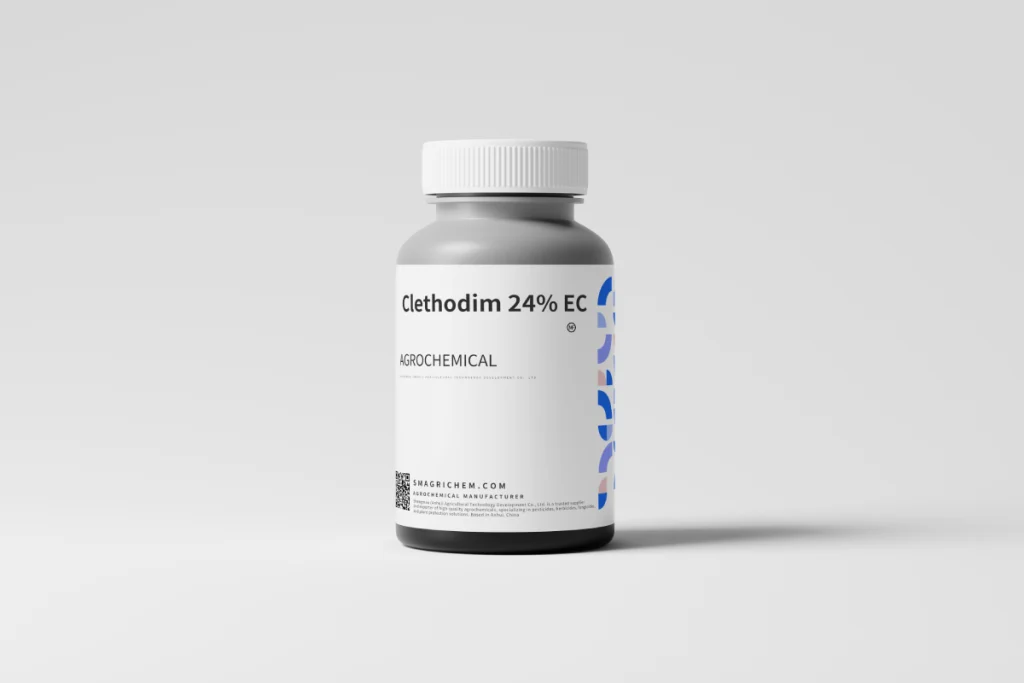- Mechanism: Inhibits protoporphyrinogen oxidase (PPO), disrupting chlorophyll synthesis → accumulation of reactive oxygen species → cell membrane damage → necrosis and plant death.
- Application Timing:
- Pre-emergence: Forms a soil barrier to kill germinating weed seedlings.
- Post-emergence: Acts on contact with foliage, effective on young, actively growing weeds.
| Crops |
Target Weeds |
Formulation/Dosage |
Application Method |
| Rice |
Barnyardgrass, sedges |
23.5% EC: 25–30 mL/ha |
Foliar spray (post-emergence) |
| Onions |
Pigweed, lambsquarters |
24% EC: 20–40 mL/ha |
Pre-emergence spray |
| Cotton |
Foxtail, sesbania |
25% SC: 200–400 mL/ha |
Soil treatment |
| Fruit Trees |
Mandrake, annual grasses |
2% Granular: 0.5–1 kg/ha |
Pre-emergence spread |
| Vegetables |
Annual weeds (e.g., crabgrass) |
95% TC: Adjusted by soil type |
Pre-emergence soil mix |
- Common Formulations:
- EC (Emulsifiable Concentrate): 20%, 23.5%, 24%, 480 g/L
- SC (Soluble Concentrate): 5%, 25%, 35%
- Granular: 2%
- TC (Technical Concentrate): 95%
- Packaging:
- Small: 1L, 5L bottles (EC/SC)
- Bulk: 200L drums, 1000L IBCs (TC/Granular)
- Broad-Spectrum Control: Effective against dicots (pigweed, lambsquarters) and monocots (foxtail, barnyardgrass).
- Rainfast: Low water solubility ensures efficacy after rainfall.
- Residual Activity: Provides 2–4 weeks of soil residual control, reducing reapplication needs.
- Tank Mix Compatibility: Mixes with pendimethalin, sulfentrazone, or isoxaben for extended weed spectrum.
- Timing:
- Pre-emergence: Apply before crop emergence or within 1–2 days of planting.
- Post-emergence: Target young weeds (cotyledon to 2-leaf stage).
- Mixing:
- Dilute in water according to soil type (lower rates for sandy soil, higher for clay).
- Avoid mixing with alkaline herbicides to prevent antagonism.
- Coverage: Ensure uniform spray coverage for post-emergence applications; incorporate granular formulations into topsoil.
- Toxicity:
- High risk to bees and aquatic life; avoid spraying near water bodies or flowering crops.
- Moderate toxicity to mammals; wear gloves and goggles during application.
- Storage: Cool, dry place; keep away from food and feed.
- Environmental Impact:
- Low soil mobility; degrades via photolysis and microbial activity.
- Avoid overuse to prevent resistance in weed populations.
- Mode of Action Group: 14 (PPO inhibitors).
- Certifications: Compliant with ISO 9001 and regional standards (e.g., ICAMA for China).
- Crop Safety: Avoid use on stressed crops (drought, extreme temperatures) to minimize phytotoxicity risks (e.g., leaf bleaching in garlic).
- 23.5% EC: Ideal for rice and cotton, targeting annual grasses post-emergence.
- 24% EC: Suited for onions and fruit trees, offering pre- and early post-emergence control.
- 25% SC: Low-dose formulation for vegetables and forestry nurseries, effective on broadleaf weeds.
FAQ
How Does Oxyfluorfen Work?
Oxyfluorfen works by inhibiting the enzyme protoporphyrinogen oxidase (PPO) in plants. This enzyme is crucial for chlorophyll synthesis. When inhibited, protoporphyrin IX accumulates, which then generates reactive oxygen species (ROS) in the presence of light and oxygen. These ROS cause damage to cell membranes, leading to lipid peroxidation, disruption of cellular functions, and ultimately necrosis and death of the plant. It can act as both a pre – emergence and post – emergence herbicide. As a pre – emergence herbicide, it forms a barrier in the soil that affects germinating weed seedlings, while as a post – emergence herbicide, it damages the foliage of young, actively growing weeds upon contact.
What is the Mode of Action of Oxyfluorfen?
The mode of action of oxyfluorfen centers around its inhibition of PPO. By blocking PPO, it disrupts the normal biosynthesis of chlorophyll and heme in plants. Without proper chlorophyll synthesis, plants cannot carry out photosynthesis effectively. The accumulation of toxic intermediates due to PPO inhibition triggers oxidative stress, resulting in the breakdown of cell membranes and cellular structures. This leads to the death of susceptible plants, whether they are emerging from the soil (pre – emergence control) or already established (post – emergence control).
What is the Mode of Action of Oxyfluorfen 23.5 EC?
Oxyfluorfen 23.5 EC (Emulsifiable Concentrate) has the same fundamental mode of action as other oxyfluorfen formulations. The 23.5 EC formulation contains 23.5% of the active ingredient oxyfluorfen. Once applied, whether pre – or post – emergence, the oxyfluorfen in the 23.5 EC formulation inhibits PPO in weed plants. This causes the build – up of protoporphyrin IX, generation of ROS, and subsequent damage to cell membranes, leading to the death of weeds. The emulsifiable concentrate form allows for relatively easy mixing with water for uniform application.
What Crops Can Benefit from Oxyfluorfen?
Many crops can benefit from oxyfluorfen. In row crops, it is commonly used in rice, cotton, and soybeans to control a variety of broadleaf and grassy weeds. In vegetable crops, it can be applied in onions, garlic, and other bulb crops. It is also useful in fruit trees, such as orchards, to manage weed growth around the base of the trees. Additionally, it can be employed in some specialty crops and in forestry nurseries to keep weed competition at bay.
Can Oxyfluorfen Be Used on Onions and Garlic?
Yes, oxyfluorfen can be used on onions and garlic. It is typically applied as a pre – emergence herbicide to control a wide range of annual broadleaf and grassy weeds. When used correctly, it helps reduce weed competition, allowing onions and garlic to grow without being hindered by weeds. However, it’s important to follow the recommended dosage and application timings carefully to avoid any potential phytotoxicity issues, especially as these crops can be sensitive to herbicides.
What Are the Uses of Oxyfluorfen 23.5 EC?
Oxyfluorfen 23.5 EC is used for broad – spectrum weed control in various crops. In rice, it can be applied post – emergence to target barnyardgrass and sedges. For cotton, it is useful for pre – emergence soil treatment to control weeds like foxtail and sesbania. In onion cultivation, it can be applied pre – emergence to manage pigweed, lambsquarters, and other annual weeds. The 23.5 EC formulation is often mixed with water and applied via foliar spray or soil application depending on the crop and the stage of weed growth.
What Are the Uses of Oxyfluorfen Herbicide?
The main use of oxyfluorfen herbicide is to control broadleaf and grassy weeds in agricultural and horticultural settings. It can be applied pre – emergence to prevent weed seeds from germinating properly by creating a toxic layer in the soil for emerging seedlings. Post – emergence, it is effective against young, actively growing weeds, damaging their foliage and inhibiting their growth. It is used in a wide variety of crops including grains, vegetables, fruits, and in some non – crop areas like nurseries and along fence lines to manage weed populations.
What Are the Recommended Uses of Oxyfluorfen for Onions?
For onions, oxyfluorfen is typically recommended as a pre – emergence herbicide. The dosage may vary depending on the formulation used, but generally, for a common formulation like 24% EC, 20 – 40 mL/ha is applied. It should be applied as a uniform spray over the soil surface before onion emergence. This helps control annual broadleaf weeds such as pigweed and lambsquarters, as well as some grassy weeds. It’s important to ensure good soil coverage and to avoid applying when there is a high risk of heavy rainfall soon after application, as this can reduce its effectiveness.
Can Oxyfluorfen 23.5 EC Be Used in Rice?
Yes, oxyfluorfen 23.5 EC can be used in rice. It is often applied post – emergence to control weeds such as barnyardgrass and sedges. The recommended dosage is usually around 25 – 30 mL/ha, mixed with an appropriate amount of water for foliar spraying. When using in rice, it’s crucial to apply at the right growth stage of the weeds and the rice plants to ensure effective weed control while minimizing any potential negative impacts on the rice crop.
What is the Dosage of Oxyfluorfen 23.5 EC?
The dosage of oxyfluorfen 23.5 EC varies depending on the crop and the target weeds. For example, in rice, the dosage is typically 25 – 30 mL/ha for post – emergence weed control. In cotton, for pre – emergence soil treatment, it may range from 200 – 400 mL/ha. For onion pre – emergence application, a lower dosage in the range of 20 – 40 mL/ha is common. These dosages are guidelines, and it’s important to refer to the product label and local agricultural extension services for the most accurate and up – to – date dosage information for specific applications.
What is the Dosage of Oxyfluorfen Herbicide?
The dosage of oxyfluorfen herbicide depends on multiple factors including the formulation (e.g., EC, SC, Granular), the crop being grown, the target weeds, and the application method (pre – or post – emergence). For a general pre – emergence application in vegetables, a dosage of 1 – 2 kg/ha of a 95% TC (Technical Concentrate) formulation might be used, adjusted according to soil type. In row crops like soybeans, the dosage for a post – emergence application of an appropriate formulation could range from 50 – 200 mL/ha. Always consult the product label and local agricultural experts for precise dosage recommendations.
Herbicides Containing Sulfentrazone and Oxyfluorfen
Herbicides containing both sulfentrazone and oxyfluorfen offer a broader spectrum of weed control. Sulfentrazone is also a PPO inhibitor, similar to oxyfluorfen, but with its own unique properties. When combined, these two active ingredients can control a wider variety of broadleaf and grassy weeds. They are often used in pre – emergence or early post – emergence applications in crops such as cotton, soybeans, and vegetables. The combination provides both soil – residual and contact – activity, enhancing the overall effectiveness of weed management. For example, in cotton, it can control weeds like pigweed, sesbania, and crabgrass more effectively than using either herbicide alone.
Isoxaben, Oxadiazon, and Oxyfluorfen
Isoxaben, oxadiazon, and oxyfluorfen are all herbicides with different but complementary modes of action. Isoxaben inhibits cell wall synthesis in germinating weed seedlings, oxadiazon is also a PPO inhibitor like oxyfluorfen, and oxyfluorfen, as described, disrupts chlorophyll synthesis. When used in combination or in rotation, they can provide comprehensive weed control in various crops. For example, in some vegetable crops, a pre – planting application of isoxaben followed by an application of a mixture of oxadiazon and oxyfluorfen can control a wide range of annual broadleaf and grassy weeds throughout the growing season. This combination approach helps manage different weed species and reduces the risk of weed resistance development.
Sulfentrazone and Oxyfluorfen
Sulfentrazone and oxyfluorfen, when combined, offer enhanced weed – killing capabilities. Both are PPO inhibitors, but they may have different affinities for various weed species and growth stages. In pre – emergence applications, they work together to create a more effective soil – residual barrier against germinating weeds. Post – emergence, they can quickly damage the foliage of emerging weeds. In crops like soybeans, this combination can control difficult – to – manage weeds such as waterhemp and Palmer amaranth. The mixture allows for a more comprehensive approach to weed control, reducing the reliance on a single herbicide and potentially extending the lifespan of the herbicide program by delaying the development of weed resistance.
Oxyfluorfen + Pendimethalin
The combination of oxyfluorfen and pendimethalin is a popular choice for weed control in many crops. Pendimethalin is a mitotic inhibitor that prevents cell division in weed seedlings, while oxyfluorfen disrupts chlorophyll synthesis. Together, they provide both pre – emergence and early post – emergence control of a wide variety of broadleaf and grassy weeds. In cotton, for example, an application of this mixture before planting can effectively control weeds like crabgrass, foxtail, and pigweed. The two herbicides work synergistically, with pendimethalin targeting emerging seedlings and oxyfluorfen providing additional contact – activity on young weeds, resulting in more efficient and long – lasting weed management.




